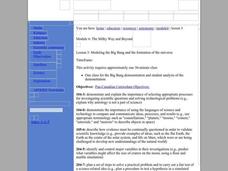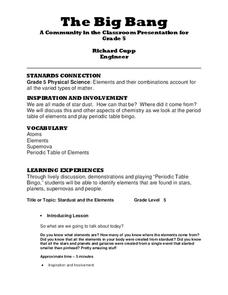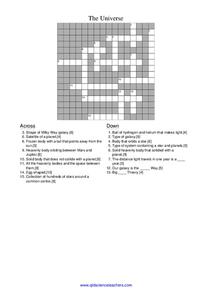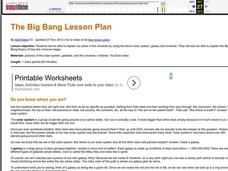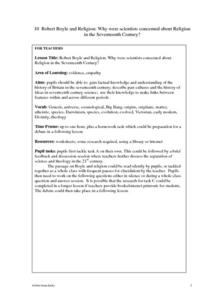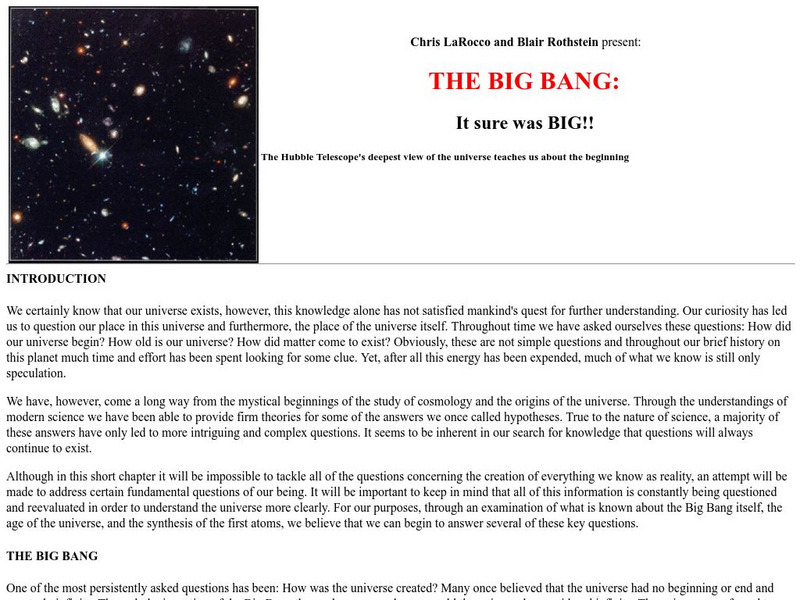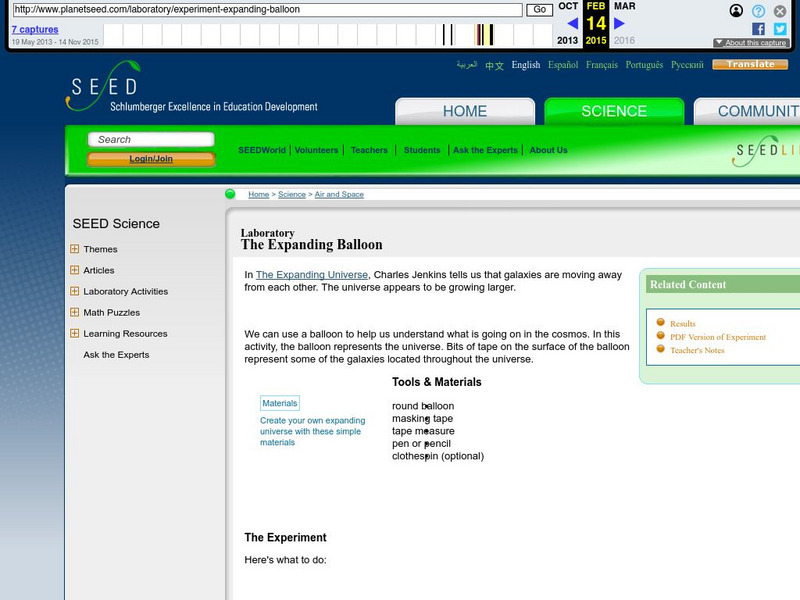Curated OER
A Brief History of Life: How Did Everything Begin?
Addressing the idea of intelligent design, as well as a number of creation myths, this presentation gives a measured and scientific perspective to the beginning of the world. It includes a graphic on the Big Bang Theory, evolution,...
Curated OER
Learning from Light: The Big Bang
Students explore what astronomers are able to examine our galaxy and universe by examining light. They explore in this sub-unit the formation of the universe, commonly called "The Big Bang," and it follows studying from the Light: The...
Curated OER
Modeling the Big Bang and the Formation of the Universe
Sixth graders conduct an experiment to understand the Big Bang Theory. In this Big Bang Theory lesson, 6th graders will observe a balloon with confetti popping to emulate and analyze information related tot he Big Bang theory....
Curated OER
Space: The Universe As We Know It!
Students simulate the Big Bang. For this lesson on the origin of our universe, students role play to show how the Big Bang explosion may have created our universe.
Curated OER
Bang! You're Alive
Students explore the Big Bang Theory and the Theory of Plate Tectonics. In this history of life activity, students explain two ways the Theory of Plate Tectonics and the Big Bang are of direct benefits to humans.
Curated OER
Exploring the Big Bang with the LHC
In this Big Bang Theory learning exercise, students read about how scientists simulate the original Big Bang conditions using atom smashers. Students solve 4 problems given about the Big Bang. They find the average collision energy of...
Curated OER
The Big Bang-Cosmic Expansion
In this Big Bang worksheet, learners are given the equation used to determine the rate at which the universe is expanding according to the Big Bang theory. Students solve 4 problems using this equation. They find the integral for time,...
Curated OER
The Big Bang-Hubble's Law
In this Hubble's law worksheet, students use data for galaxies which include their distance and speed. Students make a graph to show the distance to each galaxy and the speed of each galaxy. They use their graph to answer 4 questions...
Curated OER
Integrating Space Science-Our Changing Universe
In this universe learning exercise, students read about the big bang theory and the evolution of the stars from the elements. Students answer four critical thinking questions about the beginnings of our universe.
Curated OER
The Big Bang Theory
Students will use scientific reasoning to formulate ideas about the formation of the universe using the Big Bang Theory. The use of critical thinking skills is part of the activity and the foundation of the scientific method will serve...
Curated OER
What a Cosmic Web We Weave
Students explore, using journals and discussion in small groups, how the universe has evolved since the theoretical Big Bang and create dramatizations of various eras in cosmic evolution.
Curated OER
The Big Bang
Fifth graders relate the elements in the human body to those produced during a supernova. In this space science and chemistry instructional activity, 5th graders listen to a lecture and view visuals about the big bang. They relate the...
Curated OER
The Universe
In this space science instructional activity, students use the clues given at the bottom of the sheet to complete the crossword puzzle relating to the universe. There are 16 clues to solve in the puzzle.
Curated OER
History of the Universe
Learners describe how the universe was formed. In this astronomy lesson, students listen and respond to questions in a PowerPoint lesson that includes various theories about how the universe was created.
Curated OER
Exploring Big Bang Evidence
Ninth graders study the Big Bang theory. In this big bang theory lesson students research the Internet and complete several activities and create a presentation.
Curated OER
The Big Bang
Students explore our universe. In this solar system lesson, students gain knowledge about the solar system, galaxy, the universe and the Big Bang Theory. Students watch videos and view a slideshow.
Curated OER
The Big Bang Theory
Students explore the Big Bang Theory and discover how it can be used to explain the origin of the universe. For this Big Bang Theory lesson, students use a balloon with colored paper inside, blow it up and pop it, group the colored...
Curated OER
Astronomy
In this astronomy worksheet, learners find fifty one words in a word search that are related to comets, galaxies, planets, moons, stars and the tides.
Curated OER
Scavenger Hunt: Who am I?
In this space science instructional activity, learners use the sites listed on the Solar System and Planets page of the Kid Zone to locate the names of the people credited with each discovery. They identify and name 26 different...
Curated OER
Who Ever Heard of the Big Bang?
Students examine the theories that attempt to explain the origins of the Universe. Some theories are based on scientific facts. Others find their source in folklore. The variety of beliefs systems are discussed as a motivating factor for...
Curated OER
Robert Boyle and Religion
High schoolers discuss past cultures and the history of ideas in seventeenth century science. They answer a list of questions and prepare for a debate on the subjects of science and religion and views on how the universe was created.
University of Michigan
University of Michigan: The Big Bang It Sure Was Big!
A detailed examination of "what is known about the Big Bang itself, the age of the universe, and the synthesis of the first atoms."
Other
The Expanding Balloon Experiment
Great science experiment to help aide in the understanding of the Big Bang Theory. Students are able to complete this experiment with little materials and individually.
Utah Education Network
Uen: Where Did the Matter in the Universe Come From?
Students use various articles about how atoms are made and spread throughout the universe starting with the Big Bang. They will study the articles as groups and will then present their information to the class.











